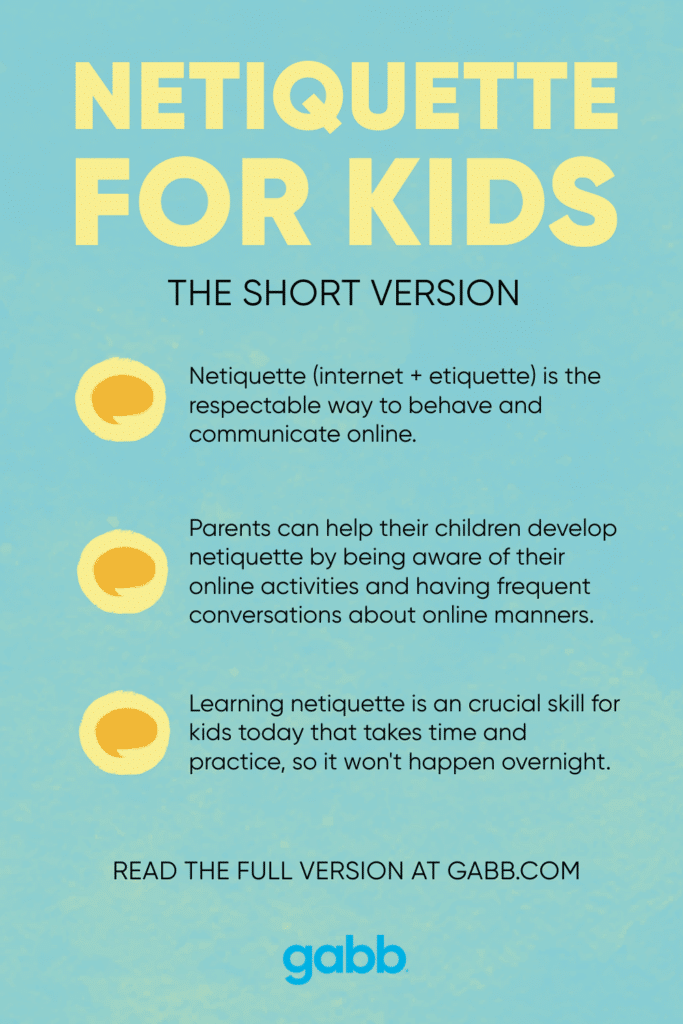When it comes to internet etiquette, the basic rules are clear: respect, consideration, and honesty reign supreme.
Your children may already possess these qualities, thanks to their real life experiences. By instilling good netiquette principles early on, kids are not only being taught manners, they are being equipped to safeguard themselves and others in the digital world.
What is Netiquette?
Netiquette (a combination of the words internet and etiquette) is the way to behave and communicate respectfully online.
As our social circle grows, it becomes imperative for children to understand the importance of respectful behavior, even in virtual interactions.
It’s vital to remember that the individuals behind the screens are real people with families and feelings. Encouraging children to recognize the humanity in everyone they encounter online cultivates a natural inclination towards kindness and empathy.
Online Safety for Kids
Although internet users can benefit from its endless knowledge and expand their cultural awareness, it can also be used to exploit children.
Young people face threats they may never have to deal with in the real world, such as identity theft, hate speech, harassment, and cyberbullying. Kids are particularly vulnerable to abuse because they are generally underprepared to withstand it.
Even adults make mistakes and share information they shouldn’t share online, resulting in strained relationships. Without awareness and guidelines, children can’t be expected to engage safely and appropriately.
By teaching your kids how to behave online, you’re keeping them in check and taking power away from abusers. Below you’ll find some suggestions for having open conversations with your children about online etiquette and digital citizenship.
Staying Safe on the Internet
It’s easy to think we’re safe behind our screens, but if we’re not careful, information can spread quickly and anonymously. The best way to protect your children online is to discuss internet safety with them.
Only about a third of teens say their parents know ‘a lot’ about what they do online (32%), the apps they use (29%), or what they do on social media (32%).
— Common Sense Media
Being aware of how they spend their time online will also safeguard their hearts, minds, and privacy. Conversations between kids and parents are the best way to understand children’s behavior online.
Conversation Starters
Frequent conversations are the easiest way to get kids to mind their manners online and on the phone. Don’t be afraid to share your own stories! Your kids will laugh and learn from you. Here are some ideas to start the conversation.
- What kinds of information do you feel comfortable sharing about yourself and others online? What could be risky about making this information public?
- What would you do if you saw someone bullied online? Have you ever experienced bullying from someone in this way? How could you help?
- Have you ever heard of a digital footprint? Eventually, each of us will have a really big one! It’s important to pause and think before you post. How do you think your digital footprint might affect you in the future?
- When is it okay to be on your phone when other people are around? When should we put our phones away?
- How would you react if a stranger started messaging you online? What situations would make you uncomfortable? Let’s talk about a safety plan.
- In what ways can you make your online platform a safe and positive place for yourself and others?
Helping Kids Protect Privacy
Youngsters must be taught how to respect and protect each other’s privacy online. Teach your child to ask for consent before sharing photos, videos, and social media posts, including personal information about others, like faces, license plates, phone numbers, and email addresses.

Encourage your child to be aware of their own digital footprint and be honest about how they present themselves online. Understanding the concept of digital permanence is essential. Once something has been posted online, it is there forever, even private messages.
Phone Etiquette
Because phones are mobile, we use them throughout the day. That means we’ve got to think about how our smartphone use affects those around us.
Kids need to know when they can use their phones in public. Parents can model appropriate behavior by setting phones aside and prioritizing the people around us during a face-to-face conversation.
Phone Etiquette for Kids: 15 Tips to Consider
Below is a list of several ideas you could consider discussing with your kid to help them develop good phone skills.
1. Be Prepared
- Make sure your device is fully charged and reachable.
2. Use a Quiet Voice
- Keep private things private and be considerate of those around you while talking on the phone.
3. Be Polite
- If you’re making a public call, tell those around you.
- Always begin a call with a pleasant greeting.
- In group chats, avoid isolating others with inside jokes only a few understand.
4. Wait to Share
- Before sharing personal details, make sure you know who you are talking to.
- Remember that not everyone online is who they say they are.
- Take some time to process your emotions before you post.
5. Be Coherent
- Use a slow, clear voice so others can understand you.
- If sending a text message, use spelling and grammar that conveys both the meaning and emotion of your message.
6. Give Details
- If leaving a voicemail, share your name, number, and why you’re calling.
- If requesting a call back via text, provide a quick explanation of why.
7. Be Discreet
- Keep your notifications at a low volume so you don’t disturb others.
- If listening to music on your device, use headphones.
8. Maintain Your Privacy
- Choose a screen name for online interactions to protect your identity.
- Never share your passwords.
- Avoid disclosing your location online, this includes identifying images such as your house and school.
9. Be Pleasant
- Keep your phone on vibrate or choose a ringtone that isn’t obnoxious.
- Avoid using speaker phone for conversations while in public.
- Avoid Spamming others with repeated texts or phone calls. Allow people time to respond.
10. Protect Others
- Don’t share personal photos or videos of someone else without their consent.
- Don’t share or like hurtful content.
11. Stay Out of Flame Wars
- Flame wars are heated and aggressive exchanges between participants of an online conversation.
12. Be Responsive
- Respond to calls and messages (especially from mom and dad), but always prioritize face-to-face interactions.
13. Be Safe
- Answer calls and messages only if it’s safe and convenient.
14. Mind Your Manners
- Behave respectfully and kindly online.
- Anonymity is no excuse to be rude.
15. Drive Responsibly
- As the driver, never use your phone while the car is in motion.
Learning netiquette takes time and practice. Talking it through together is a great way to see where they need more help. Expect missteps and bumps in the road — becoming safe and competent online won’t happen overnight.

Teaching your child netiquette includes setting them up for success. There are many ways to prepare them, such as using tech in steps, or providing them with a kid-safe device.
How have you learned netiquette? How would you teach it to your kids? Let us know in the comments!









Success!
Your comment has been submitted for review! We will notify you when it has been approved and posted!
Thank you!